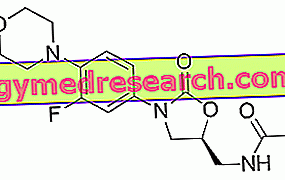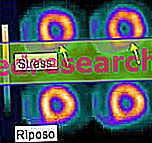Linezolid is an antibiotic active against Gram-positive aerobic bacteria, in particular, it is used in the treatment of infections caused by methicillin-resistant staphylococcus (MRSA infections).

Linezolid - Chemical Structure
It is an antibiotic available both for oral administration and for parenteral administration.
Indications
For what it uses
The use of linezolid is indicated for the treatment of:
- MRSA infections;
- Nosocomial pneumonias;
- Community-acquired pneumonia;
- Skin infections and cutaneous appendages caused by microorganisms sensitive to linezolid.
Warnings
Before taking linezolid, inform your doctor if you are in any of the following conditions:
- If you suffer from hypertension;
- If you suffer from overactive thyroid;
- If you are suffering from pheochromocytoma or carcinoid syndrome;
- If you suffer from any mental disorder;
- If you have anemia, leukopenia or thrombocytopenia;
- If you have a history of convulsive disorders.
Linezolid can cause side effects that can affect the ability to drive and / or operate machinery, so great care must be taken.
Interactions
Linezolid should not be taken concomitantly with IMAO (monoamine oxidase inhibitors, drugs used to treat depression or Parkinson's disease).
Also, you need to tell your doctor if you are already on any of the following medications:
- Decongestants, such as pseudoephedrine or phenylpropanolamine;
- Anti- asthmatic drugs, such as salbutamol, terbutaline or fenoterol;
- Tricyclic antidepressants or SSRIs (selective serotonin reuptake inhibitors), such as amitriptyline, clomipramine, imipramine, fluoxetine, fluvoxamine, paroxetine or sertraline;
- Adrenaline (or epinephrine ), used in the treatment of severe and sudden allergic reactions;
- Drugs capable of raising blood pressure, such as norepinephrine, dobutamine or dopamine ;
- Petidina, an opioid analgesic;
- Anxiolytic drugs;
- Oral anticoagulants, such as warfarin.
If you are taking any of the above mentioned drugs and you need to start linezolid therapy, your doctor - before starting treatment with the antibiotic - can decide to carry out checks on the patient's general health and blood pressure.
Furthermore, linezolid can react with a substance present in many foods called tyramine .
In any case, you need to inform your doctor if you are taking - or if you have recently been - drugs of any kind, including over-the-counter drugs and herbal and / or homeopathic products.
Side effects
Linezolid can induce various types of side effects, although not all patients experience them. This is due to the different sensitivity that each individual has towards the drug. Therefore, it is not said that the undesirable effects occur all with the same intensity in each person.
Listed below are some of the side effects that may occur during linezolid therapy.
Allergic reactions
Treatment with linezolid can trigger allergic reactions in sensitive individuals. These reactions can occur with symptoms such as:
- Dermatitis;
- Redness and pain in the skin;
- Skin eruptions;
- Itching or swelling of the face and neck.
Eye disorders
Linezolid therapy may cause:
- Blurred vision;
- Alteration of color vision;
- Difficulty in seeing the details;
- Visual field restriction.
Gastrointestinal disorders
Treatment with linezolid may cause:
- Nausea or vomiting;
- Dyspepsia;
- Abdominal pain;
- Constipation;
- Soft stools;
- Diarrhea;
- pancreatitis;
- Glossitis;
- gastritis;
- Stomatitis.
If the diarrhea occurs in a severe form or contains blood, it is necessary to inform the doctor immediately, as it could be a sign of the occurrence of pseudomembranous colitis that requires adequate treatment.
Skin and subcutaneous tissue disorders
Linezolid therapy can cause skin rashes, bullous rashes, hives, itching, increased sweating and alopecia.
Urogenital disorders
Treatment with linezolid may cause polyuria, vaginal and vulvovaginitis disorders.
Fungal infections
Linezolid therapy may promote the onset of fungal infections, especially of oral (thrush) and vaginal candidiasis.
Cardiovascular disorders
Treatment with linezolid can cause changes in heart rate and hypertension.
Blood and lymphatic system disorders
Linezolid-based therapy can promote the onset of:
- Anemia;
- Eosinophilia, ie increase in the number of eosinophils in the bloodstream;
- Leukopenia, ie decrease in the number of white blood cells in the bloodstream;
- Plateletopenia, ie decrease in the number of platelets in the blood.
Snow system disorders
Treatment with linezolid may cause:
- Dizziness;
- Insomnia;
- Hypoaesthesia;
- paresthesia;
- dizziness;
- Headache;
- Convulsions.
Other side effects
Other side effects that may occur during linezolid therapy are:
- Kidney failure;
- Temperature;
- Chills;
- Fatigue;
- Dry mouth;
- Increased thirst;
- Swollen tongue, painful and / or discolored;
- Surface discoloration of teeth;
- Hyponatremia, that is, decrease in the amount of sodium in the bloodstream;
- Lactic acidosis;
- Tinnitus, that is an auditory disorder characterized by the perception of whistling, buzzing, rustling, etc .;
- Pain at the injection site (in the case of intravenous administration);
- Phlebitis or thrombophlebitis (in the case of intravenous administration);
- Serotonin syndrome (very rarely).
Overdose
If you suspect that you have taken too much linezolid, you must immediately tell your doctor.
Action mechanism
Linezolid performs its antibiotic action by interfering with bacterial protein synthesis.
Protein synthesis in bacterial cells takes place thanks to organelles called ribosomes.
Ribosomes consist of ribosomal RNA and proteins associated with each other to form two subunits:
- The 30S subunit, consisting of 21 proteins and one RNA molecule (16S);
- The 50S subunit, consisting of 34 proteins and two RNA molecules (23S and 5S).
The task of these organelles is to bind and translate the messenger RNA that comes from the cell nucleus and to synthesize the proteins for which it encodes.
Linezolid binds to the 23S ribosomal RNA molecule present within the 50S subunit, thereby inhibiting protein synthesis.
Linezolid is considered bacteriostatic (ie it inhibits the growth of bacterial cells) against enterococci and staphylococci and bactericidal (ie able to kill bacterial cells) against streptococci.
Mode of Use - Posology
Linezolid is available for oral administration in the form of tablets and for intravenous administration in the form of bags containing a ready-to-use solution.
The doses of linezolid usually used are the same for both oral and intravenous administration.
In particular, in adults, the usual dose of drug is 600 mg twice a day, usually with an interval of twelve hours between one administration and another.
Treatment generally lasts 10-14 days, but - if deemed necessary - the doctor can prolong the therapy.
In children and adolescents under 18 years of age, linezolid is not used.
Pregnancy and breastfeeding
Since no data are available on the safe use of linezolid by pregnant women, treatment with the drug in this category of patients should only be done if the doctor considers it absolutely necessary and only under his supervision.
Linezolid is excreted in breast milk and could cause damage to the newborn, therefore breast-feeding mothers should not take the drug.
Contraindications
The use of linezolid is contraindicated in the following cases:
- In patients with known hypersensitivity to the same linezolid;
- In patients taking - or having taken in the last two weeks - monoamine oxidase inhibitors;
- During breastfeeding.



